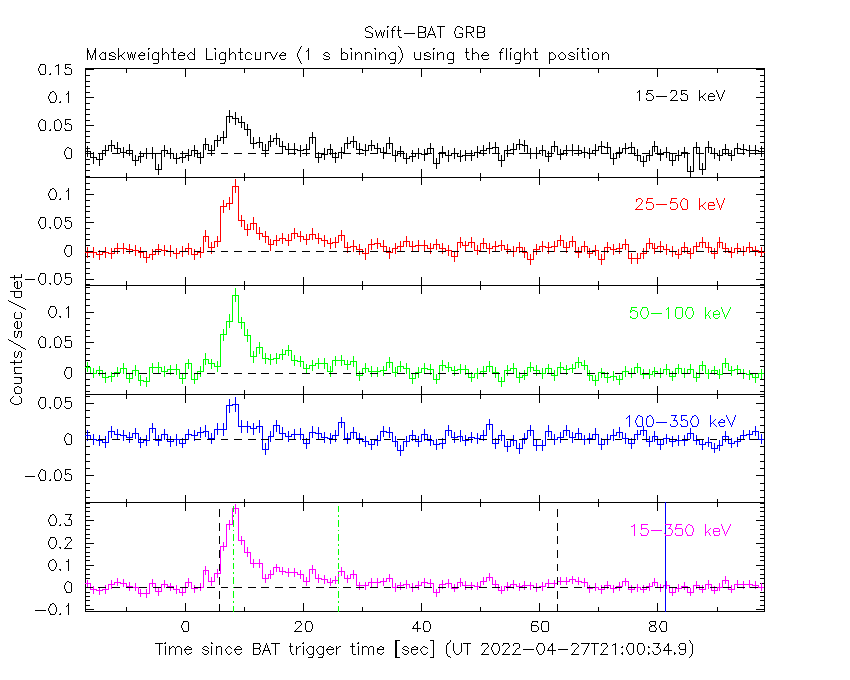
A. D'Ai (INAF-IASFPA) and A.P. Beardmore (U. Leicester) for the Swift team
At 21:00:34 UT, the Swift Burst Alert Telescope (BAT) triggered and located GRB 220427A (trigger=1104343) (D'Ai et al. GCN Circ. 31960). Swift slewed immediately to the burst. At the time of the trigger, the initial BAT position was 118° from the Sun (7.9 hours West) and 86° from the 9%-illuminated Moon. Table 1 contains the best reported positions from Swift, and the latest XRT position can be viewed at http://www.swift.ac.uk/xrt_positions.
D'Ai et al. (GCN Circ. 31960) reported the discovery with UVOT of an optical afterglow. Table 2 is a summary of GCN Circulars about this GRB from observatories other than Swift.
Standard analysis products for this burst are available at https://gcn.gsfc.nasa.gov/swift_gnd_ana.html.
As reported by Stamatikos et al. (GCN Circ. 31968),
the BAT ground-calculated position is RA, Dec = 275.922, -56.257 deg which is RA(J2000) = 1
The mask-weighted light curve (Figure 1) shows a single-peaked structure that starts at ~T+3 s and peaks at ~T+8 s, and followed by a long tail emission that ends at ~T+70 s.
The time-averaged spectrum from T+3.09 to T+68.06 s is best fit by a simple power-law model.
The power law index of the time-averaged spectrum is 1.23 ± 0.13.
The fluence in the 15-150 keV band is 2.1 ± 0.2 x 1
The results of the batgrbproduct analysis are available at https://gcn.gsfc.nasa.gov/notices_s/1104343/BA/.
Analysis of the initial XRT data was reported by Beardmore et al. (GCN Circ. 31963). We have analysed 23 ks of XRT data for GRB 220427A, from 162 s to 419.5 ks after the BAT trigger. The data comprise 37 s in Windowed Timing (WT) mode (the first 10 s were taken while Swift was slewing) with the remainder in Photon Counting (PC) mode. The enhanced XRT position for this burst was given by Goad et al. (GCN Circ. 31962).
The light curve (Figure 2) can be modelled with a power-law decay with a decay index of α=1.08 ± 0.04.
A spectrum formed from the PC mode data can be fitted with an absorbed power-law with a photon spectral index of 2.02 ± 0.15. The best-fitting absorption column is 1.6 (+0.5, -0.4) x 1
A summary of the PC-mode spectrum is thus:
Total column: 1.6 (+0.5, -0.4) x 1
Galactic foreground: 1.0 x 1
Excess significance: 2.4 σ
Photon index: 2.02 ± 0.15
The results of the XRT team automatic analysis are available at http://www.swift.ac.uk/xrt_products/01104343.
UVOT results are not available.

Figure 1. The BAT
mask-weighted light curve in the four individual and total
energy bands. The units are counts

Figure 2. The XRT light curve.
Any data from a crosshatched region are not included in the fit.
| RA (J2000) | Dec (J2000) | Error | Note | Reference |
|---|---|---|---|---|
| 1 |
-56°15'18.3" | 0.61" | UVOT-initial | D'Ai et al. GCN Circ. 31960 |
| 1 |
-56°15'18.4" | 2.0" | XRT-final | UKSSDC |
| 1 |
-56°15'19.5" | 2.5" | XRT-enhanced | Goad et al. GCN Circ. 31962 |
| 1 |
-56°15'23.7" | 2.0' | BAT-refined | Stamatikos et al. GCN Circ. 31968 |
| Band | Authors | GCN Circ. | Subject | Observatory | Notes |
|---|---|---|---|---|---|
| Optical | de Ugarte Postigo et al. | 31967 | VLT/X-shooter photometry | VLT | |
| Optical | Klotz et al. | 31991 | GRANDMA Early Optical Afterglow Detection |
GRANDMA | detection |
| Optical | Strausbaugh and Cucchiara | 31995 | LCO Optical Observations | LCO | detection |
| Optical | de Wet et al. | 32032 | MeerLICHT afterglow observations | MeerLICHT | detection |
| Gamma-ray | Frederiks et al. | 31964 | Konus-Wind detection | Konus-Wind |
May 14, 2022